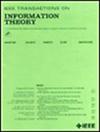高斯快速衰落信道的计算前向多址
IF 2.9
3区 计算机科学
Q3 COMPUTER SCIENCE, INFORMATION SYSTEMS
引用次数: 0
摘要
前向计算多址(CFMA)是一种传输策略,它允许多址信道(MAC)中的接收器首先解码传输信号的线性组合,然后求解单个消息。与现有的MAC策略(如联合解码或连续干扰消除(SIC))相比,CFMA仅使用单用户解码器就可以在特定信噪比(SNR)条件下实现固定信道的MAC容量区域,而无需分时。研究了信道状态信息仅在接收端可用的双用户高斯快速衰落MAC (CSIR)的CFMA方案。研究了在衰落MAC中任意整数系数线性组合的译码方案,并推导了可实现的码率对。给出了该方案能够实现遍历和容量的充分必要条件。此外,我们还研究了信道统计对CFMA方案容量可达性的影响。一般来说,如果信道方差与信道强度的平均值相比较小,则可以实现和容量。给出了不同的数值结果来说明理论结论。本文章由计算机程序翻译,如有差异,请以英文原文为准。
Compute-Forward Multiple Access for Gaussian Fast Fading Channels
Compute-forward multiple access (CFMA) is a transmission strategy which allows the receiver in a multiple access channel (MAC) to first decode linear combinations of the transmitted signals and then solve for individual messages. Compared to existing MAC strategies such as joint decoding or successive interference cancellation (SIC), CFMA was shown to achieve the MAC capacity region for fixed channels under certain signal-to-noise (SNR) conditions without time-sharing using only single-user decoders. This paper studies the CFMA scheme for a two-user Gaussian fast fading MAC with channel state information only available at the receiver (CSIR). We investigate appropriate lattice decoding schemes to decode linear combinations with any integer coefficients in the fading MAC and derive the achievable rate pairs. We give a sufficient and necessary condition under which the proposed scheme can achieve the ergodic sum capacity. Furthermore, we investigate the impact of channel statistics on the capacity achievability of the CFMA scheme. In general, the sum capacity is achievable if the channel variance is small compared to the mean value of the channel strengths. Various numerical results are presented to illustrate the theoretical findings.
求助全文
通过发布文献求助,成功后即可免费获取论文全文。
去求助
来源期刊

IEEE Transactions on Information Theory
工程技术-工程:电子与电气
CiteScore
5.70
自引率
20.00%
发文量
514
审稿时长
12 months
期刊介绍:
The IEEE Transactions on Information Theory is a journal that publishes theoretical and experimental papers concerned with the transmission, processing, and utilization of information. The boundaries of acceptable subject matter are intentionally not sharply delimited. Rather, it is hoped that as the focus of research activity changes, a flexible policy will permit this Transactions to follow suit. Current appropriate topics are best reflected by recent Tables of Contents; they are summarized in the titles of editorial areas that appear on the inside front cover.
 求助内容:
求助内容: 应助结果提醒方式:
应助结果提醒方式:


